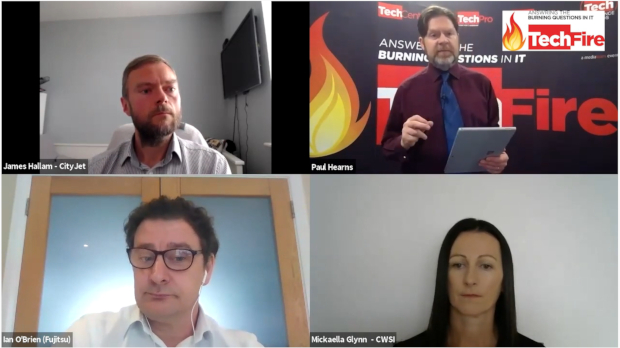
Release IT pros to work from home
Irish IT professionals should be released to work from home.
That was the broad agreement of the panel and the audience at the recent TechFire event, the first in the series to be delivered digitally.
Exploring the issues around the mass move of IT professionals to remote and home working in response to the COVID-19 pandemic, the panellists highlighted the fact that the infrastructure, services, technologies and protections are all there to facilitate remote working by IT Professionals, even though few availed of it before the pandemic.
Paul Hearns, event chair and head of content for TechPro and TechCentral.ie, highlighted the findings of the TechBeat survey that showed almost two thirds (63%) of IT pros worked from home on average less than a day per week. This was despite the fact that a combined 73% said that their productivity had either remained the same or improved. Furthermore, an overwhelming majority (82%) said that home and remote working could improve work life balance.
Technical solutions
Experts Ian O’Brien, senior solutions architect, Fujitsu, and Mickaella Glynn, head of Company Operations and People Experience, CWSI, presented on the technical underpinnings of enabling remote and home working for IT pros. Despite many IT functions not generally being administered remotely, both confirmed there are no technical bars to facilitating these functions.
James Hallam, head of IT, CityJet, described how the company has not had a formal work from home policy previously, but moved quickly to enable this in the pandemic response. Recent infrastructure upgrades had left the airline in a good position to make the move to home and remote working.
The company adapted well, said Hallam, as the normal operating model for its main line of business meant that most facilities and infrastructure were already in place to handle remote working.
However, Hallam observed what did change was team dynamics. No longer could someone share from their desk an issue they were struggling with for a quick discussion and possible resolution, he said. As such, resolution times for challenging, but not necessarily complex, issues tended to creep up. People adapted quickly, though, and other means for quick sharing and informal communication soon emerged to get people back to the levels of efficiency with which they were accustomed.
Presenteeism
A question from the audience explored the old bias of presenteeism and whether it was still an issue for Irish organisations.
CWSI’s Glynn said there are still some circumstances where people need to be present, such as facilities like network operations centres (NOC), or specialist infrastructure that is held on-premises, but that outside of these instances there is no insurmountable need.
Companies that resell services, said Glynn, might have a need, but it might also just be the old attitude of ‘if I can see you and see that you are busy then you are being productive’.
But if employees can prove that they are being productive while working remotely, there should be no question over this, she argued.
Fujitsu’s O’Brien opined that this old attitude is disappearing very quickly.
The sheer speed at which people put in the technology and then the practices has changed peoples’ views, hopefully forever, he argued.
It has showed that the technology has worked so easily that there are opportunities out there. It will show organisations that there are opportunities to perhaps bring people into the work force who couldn’t participate before, and that should have benefits for recruitment, said O’Brien.
We need to embrace this, and not go back to the old ways. We have just proven in a few weeks that the benefits are enormous, he asserted.
The panellists agreed that the broad availability of the infrastructure, tools and services to enable remote working was probably a significant factor in the thinking for the Government and the National Public Health Emergency Team (NPHET) when they were developing the emergency health measures.
Onboarding
An audience question asked about employee onboarding and new team development during the pandemic. There was broad agreement from the panellists that while it might be slightly trickier, these processes were not by any means unworkable. CityJet’s Hallam said in his experience, very little was lost in doing video interviews and so he saw little to bar organisations from engaging in such efforts currently.
The question of culture at the C-Suite level was also raised and whether there would be a broader acceptance of remote working. O’Brien was strongly of the opinion that it had.
It has changed to the point where senior execs have seen the value of this, said O’Brien. There doesn’t seem to be many blockers for remote working, with the fact that it opens up new possibilities not only for new ways of doing things, but also for who can be included in the workforce.
New intent
A poll during the event confirmed the broad proportion of IT pros (62%) who said they worked from home less than a day a week on average. By the end of the event, 94% said they would work from home more after the pandemic emergency.
While there was agreement that home and remote working could change the fundamental culture of an organisation, it was also agreed that a coherent strategy of providing remote working facilities would support attracting and retaining staff.
CWSI’s Glynn said that the facility would allow smaller organisations to compete with the larger ones that were able to woo staff with onsite benefits, from free food, gyms and dry cleaning to the desk to Friday beer fridges.
Overall, both audience and the panel agreed that IT professionals should be released to work from home, and that Irish organisations should do more to make the facility available for all.
TechCentral Reporters







Subscribers 0
Fans 0
Followers 0
Followers